
Trees in habitat; one of the photos posted on the endemia.nc page for A. columnaris [Benoît Henry 2012].
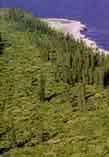
"Stand of 'pins colonnaires' on the cliffs of Lifou. Araucaria columnaris is local to the Loyalty Islands on coasts exposed to the prevailing winds" (Schmid 1981).
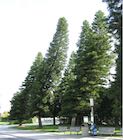
Ornamental trees at University of California, Irvine, leaning towards the equator [Figure 1 from Johns et al. 2017].

Tree about 20m tall in zocalo, Zacualpan, Nayarit [C.J. Earle, 2007.02.13].

Tree about 15 m tall and 40 cm dbh at Quail Botanical Garden, California [C.J. Earle, 2004.04.06].
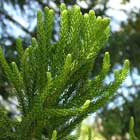
Foliage on the above tree [C.J. Earle, 2004.04.06].
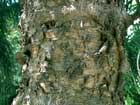
Bark on the above tree [C.J. Earle, 2004.04.06].
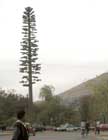
Sometimes cell phone towers try to imitate conifers. This one in the city of Oaxaca, Mexico is trying to look like an Araucaria columnaris [R. Van Pelt, 2005.02].

Conservation Status

Araucaria columnaris
(G.Forst.) Hook. 1852
Common names
Pin colonnaire [French], Cook's pine, New Caledonia pine, 柱状南洋杉 [Chinese] (Farjon et al. 2017).
Taxonomic notes
Synonymy:
- Cupressus columnaris J. R. Forst. 1786
- Dombeya excelsa Lamb. 1807
- Araucaria excelsa (Lamb.) R. Br. 1813
- Columbea excelsa (Lamb.) Spreng. 1827
- Eutacta excelsa (Lamb.) Link 1842
- Araucaria cookii R. Br. ex Endl. 1847
- Araucaria intermedia R. Br. ex Vieill. 1862
- Eutacta cookii (R. Br. ex Endl.) Carrière 1867
- Eutacta cookii var. gracilis Carrière 1867
- Eutacta humilis Carrière 1867
- Eutacta minor Carrière 1867
- Eutassa columnaris (J. R. Forst.) de Laub. 2009
- Araucaria lavoixii Silba 2014
- Araucaria neocookii Silba 2015
A molecular analysis places Araucaria columnaris into the clade of coastal species of New Caledonia, along with A. luxurians and A. nemorosa (Gaudeul et al. 2012).
Description
Monoecious evergreen trees to 60 m. tall with a narrowly conical crown. Trunk clear, then later with numerous short shoots. Bark gray, papery, exfoliating in thin strips. Twigs cord-like, growing in one plane, 9-10 mm diameter. Juvenile leaves needle-like, imbricate, lanceolate, 4-7 × 2-3 mm, apex incurved. Adult leaves scale-like, imbricate, triangular, acuminate, obtuse, midrib faint, 5-7 × 3-5 mm, apex incurved. Male cone oblong-cylindrical, 5-10 × 1.5-2.2 cm; scales triangular, finely teethed, pollen sacs 10; microsporophylls cuspidate. Seed cone 10-15 × 7-11 cm, with short bracts to 7 mm long. Seeds 3-3.5 cm long, nut ovate, wings broadly rounded. Germination epigeal (Silba 1986). See García Esteban et al. (2004) for a detailed characterization of the wood anatomy.
Distribution and Ecology
New Caledonia: Grande Terre (Province Sud), Isle of Pines, Loyalty Islands. On Grande Terre, it occurs along the SE and S coast from the Baie de Kouakoué to the Baie de Prony at the southern end of the island, and on the Ile Porc Epic near Nouméa. By the time of European arrival, it had been extensively planted by Polynesians on the Isle of Pines and the Loyalty Islands, where it is found on the Iles Ouvéa, Lifou and Maré. It is possible that the isolated population at Baie des Tortues on the SW coast was also introduced, likewise the outlying populations at Chesterfield Reefs and in Vanuatu (Aneityum). This species is littoral, and naturally established populations do not occur naturally more than 100 m from the beaches (Farjon et al. 2017).
This maps shows herbarium records of Araucaria species native to New Caledonia. Letter corresponds to first letter of species epithet (A. goroensis coded as A. muelleri, see A. goroensis for discussion). Click on an icon for further information. Distribution data from GBIF (2020.03.30), edited to remove duplicates.
Zone 10 (cold hardiness limit between -1°C and +4.4°C) (Bannister and Neuner 2001). In my experience, it is among the most common ornamental araucarias encountered in climates - such as Hawaii, New Zealand's north island, Queensland, southern California and Mexico - that are warm enough to support it.
The IUCN reports that the population status is stable.
Remarkable Specimens
I have not seen any data for trees in habitat. The largest diameter recorded is 146 cm dbh for a 44.4 m tall specimen, measured 2019, in the Auckland Domain, New Zealand (New Zealand Tree Register, accessed 2020.10.24). The tallest known specimen grows in the Botanic Garden of Rio de Janeiro, and was 51 m tall when measured on 2018.09.17. This is a laser measurement using the sine method and is assumed quite accurate (Dominique Beziat email 2018.11.12). A specimen growing as an ornamental at the Tedeschi Winery in Ulupalakua on Maui, Hawaii, was measured in 1998 as 48.8 m tall with a dbh of 120 cm (Robert Van Pelt e-mail 1998.03.18).
Ethnobotany
In the United States, at least, the majority of trees sold on the mass market as "Norfolk Island Pine" (Araucaria heterophylla) are, in fact, A. columnaris. Seed orchards in Hawaii are the principal source for this stock (discussions on Facebook "Tropical Conifers" group, August 2024). However, both species are reasonably common as ornamentals in warm-temperate parts of the U.S., such as southern California and Florida.
The species has only been touched on for dendrochronology: one study, exploring its use as a lead indicator (Medeiros et al. 2008).
Observations
Remarks
This species is unique among all the trees in the world in that it leans towards the equator. The entire tree leans, from the base to the crown, and the lean is greater with increasing latitude (Johns et al. 2017). Although this phenomenon has been demonstrated using a large sample of trees from locations around the world, the reason for the lean is not well understood. Woody plants generally grow strictly upright due to a negative geotropism, but an asymmetrical light source or lateral physical stress can cause lean; neither situation seems to apply particularly well in this case. Since leaning commonly leads to falling over, this may be an example of a deleterious gene that has not been removed from the population because the native range of the species is near the equator, where the lean is generally not apparent. By inference, A. columnaris may "have small effective population sizes, and suffer fixation of deleterious alleles" (Johns et al. 2017).
A. columnaris was first discovered to Europeans on Captain Cook's second voyage, "on that extremity of New Caledonia, called Queen Charlotte's Foreland, and on a small neighbouring Island, named by Captain Cook Botany Island, which is a mere sand bank .... also on another island, called by our voyagers the Isle of Pines, from its being almost covered with the above mentioned tree" (Lambert 1806, as cited by Farjon et al. 2017).
Citations
Farjon, A., M. Gardner M. and P. Thomas. 2017. Conifer Database (version Jan 2014). In: Roskov et al. (eds.), Species 2000 & ITIS Catalogue of Life. http://www.catalogueoflife.org/col/details/species/id/18158588, accessed 2017.04.16, now defunct.
Gaudeul, M., G. Rouhan, M.F. Gardner, and P.M. Hollingsworth. 2012. AFLP markers provide insights into the evolutionary relationships and diversification of New Caledonian Araucaria species (Araucariaceae). American Journal of Botany 99(1):68-81.
Hooker, W. J. 1852. Curtis's Botanical Magazine 78: t.4635. Available: Biodiversity Heritage Library, accessed 2023.03.04.
Johns, J. W., J. M. Yost, D. Nicolle, B. Igic, and M. K. Ritter. 2017. Worldwide hemisphere-dependent lean in Cook pines. Ecology 98(9):2482–2484.
Medeiros, J. G. S., M. Tomazello, F. J. Krug and A. E. S. Vives. 2008. Tree-ring characterization of Araucaria columnaris Hook. and its applicability as a lead indicator in environmental monitoring. Dendrochronologia 26(3):165-171.
See also
Association Endemia, a site devoted to New Caledonian species. Has excellent photos, a range map, and other information. In French.
The PROTA database account for this species (accessed 2019.02.28). PROTA accounts are focused on commercial forest uses in Africa, and typically include photographs, drawings, names, distribution, and a variety of information relevant to management of the species.








